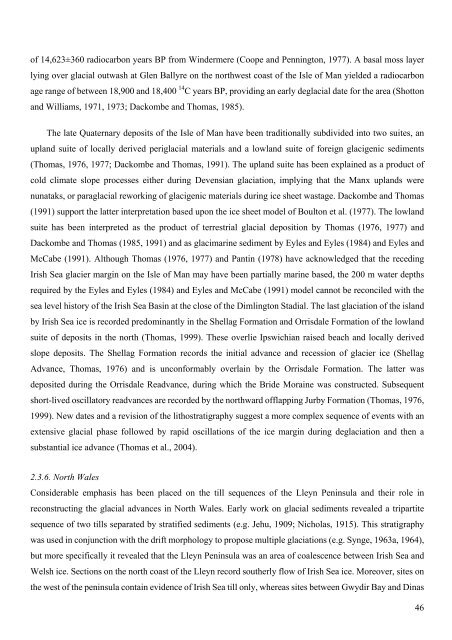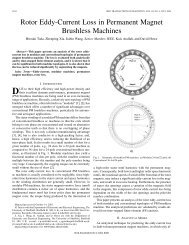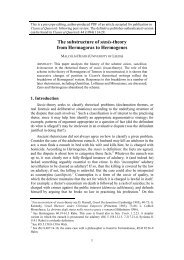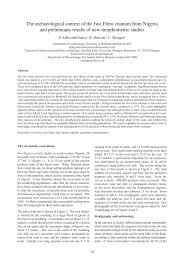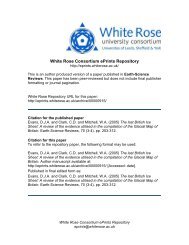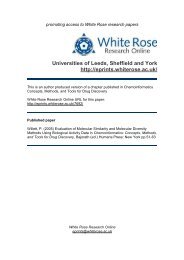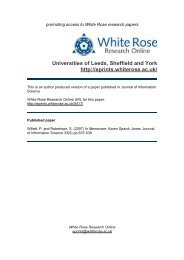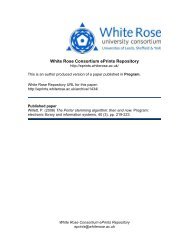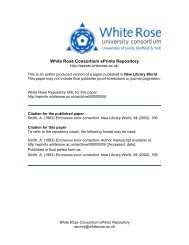The last British Ice Sheet: A review of the evidence utilised in the ...
The last British Ice Sheet: A review of the evidence utilised in the ...
The last British Ice Sheet: A review of the evidence utilised in the ...
You also want an ePaper? Increase the reach of your titles
YUMPU automatically turns print PDFs into web optimized ePapers that Google loves.
<strong>of</strong> 14,623±360 radiocarbon years BP from W<strong>in</strong>dermere (Coope and Penn<strong>in</strong>gton, 1977). A basal moss layer<br />
ly<strong>in</strong>g over glacial outwash at Glen Ballyre on <strong>the</strong> northwest coast <strong>of</strong> <strong>the</strong> Isle <strong>of</strong> Man yielded a radiocarbon<br />
age range <strong>of</strong> between 18,900 and 18,400 14 C years BP, provid<strong>in</strong>g an early deglacial date for <strong>the</strong> area (Shotton<br />
and Williams, 1971, 1973; Dackombe and Thomas, 1985).<br />
<strong>The</strong> late Quaternary deposits <strong>of</strong> <strong>the</strong> Isle <strong>of</strong> Man have been traditionally subdivided <strong>in</strong>to two suites, an<br />
upland suite <strong>of</strong> locally derived periglacial materials and a lowland suite <strong>of</strong> foreign glacigenic sediments<br />
(Thomas, 1976, 1977; Dackombe and Thomas, 1991). <strong>The</strong> upland suite has been expla<strong>in</strong>ed as a product <strong>of</strong><br />
cold climate slope processes ei<strong>the</strong>r dur<strong>in</strong>g Devensian glaciation, imply<strong>in</strong>g that <strong>the</strong> Manx uplands were<br />
nunataks, or paraglacial rework<strong>in</strong>g <strong>of</strong> glacigenic materials dur<strong>in</strong>g ice sheet wastage. Dackombe and Thomas<br />
(1991) support <strong>the</strong> latter <strong>in</strong>terpretation based upon <strong>the</strong> ice sheet model <strong>of</strong> Boulton et al. (1977). <strong>The</strong> lowland<br />
suite has been <strong>in</strong>terpreted as <strong>the</strong> product <strong>of</strong> terrestrial glacial deposition by Thomas (1976, 1977) and<br />
Dackombe and Thomas (1985, 1991) and as glacimar<strong>in</strong>e sediment by Eyles and Eyles (1984) and Eyles and<br />
McCabe (1991). Although Thomas (1976, 1977) and Pant<strong>in</strong> (1978) have acknowledged that <strong>the</strong> reced<strong>in</strong>g<br />
Irish Sea glacier marg<strong>in</strong> on <strong>the</strong> Isle <strong>of</strong> Man may have been partially mar<strong>in</strong>e based, <strong>the</strong> 200 m water depths<br />
required by <strong>the</strong> Eyles and Eyles (1984) and Eyles and McCabe (1991) model cannot be reconciled with <strong>the</strong><br />
sea level history <strong>of</strong> <strong>the</strong> Irish Sea Bas<strong>in</strong> at <strong>the</strong> close <strong>of</strong> <strong>the</strong> Diml<strong>in</strong>gton Stadial. <strong>The</strong> <strong>last</strong> glaciation <strong>of</strong> <strong>the</strong> island<br />
by Irish Sea ice is recorded predom<strong>in</strong>antly <strong>in</strong> <strong>the</strong> Shellag Formation and Orrisdale Formation <strong>of</strong> <strong>the</strong> lowland<br />
suite <strong>of</strong> deposits <strong>in</strong> <strong>the</strong> north (Thomas, 1999). <strong>The</strong>se overlie Ipswichian raised beach and locally derived<br />
slope deposits. <strong>The</strong> Shellag Formation records <strong>the</strong> <strong>in</strong>itial advance and recession <strong>of</strong> glacier ice (Shellag<br />
Advance, Thomas, 1976) and is unconformably overla<strong>in</strong> by <strong>the</strong> Orrisdale Formation. <strong>The</strong> latter was<br />
deposited dur<strong>in</strong>g <strong>the</strong> Orrisdale Readvance, dur<strong>in</strong>g which <strong>the</strong> Bride Mora<strong>in</strong>e was constructed. Subsequent<br />
short-lived oscillatory readvances are recorded by <strong>the</strong> northward <strong>of</strong>flapp<strong>in</strong>g Jurby Formation (Thomas, 1976,<br />
1999). New dates and a revision <strong>of</strong> <strong>the</strong> lithostratigraphy suggest a more complex sequence <strong>of</strong> events with an<br />
extensive glacial phase followed by rapid oscillations <strong>of</strong> <strong>the</strong> ice marg<strong>in</strong> dur<strong>in</strong>g deglaciation and <strong>the</strong>n a<br />
substantial ice advance (Thomas et al., 2004).<br />
2.3.6. North Wales<br />
Considerable emphasis has been placed on <strong>the</strong> till sequences <strong>of</strong> <strong>the</strong> Lleyn Pen<strong>in</strong>sula and <strong>the</strong>ir role <strong>in</strong><br />
reconstruct<strong>in</strong>g <strong>the</strong> glacial advances <strong>in</strong> North Wales. Early work on glacial sediments revealed a tripartite<br />
sequence <strong>of</strong> two tills separated by stratified sediments (e.g. Jehu, 1909; Nicholas, 1915). This stratigraphy<br />
was used <strong>in</strong> conjunction with <strong>the</strong> drift morphology to propose multiple glaciations (e.g. Synge, 1963a, 1964),<br />
but more specifically it revealed that <strong>the</strong> Lleyn Pen<strong>in</strong>sula was an area <strong>of</strong> coalescence between Irish Sea and<br />
Welsh ice. Sections on <strong>the</strong> north coast <strong>of</strong> <strong>the</strong> Lleyn record sou<strong>the</strong>rly flow <strong>of</strong> Irish Sea ice. Moreover, sites on<br />
<strong>the</strong> west <strong>of</strong> <strong>the</strong> pen<strong>in</strong>sula conta<strong>in</strong> <strong>evidence</strong> <strong>of</strong> Irish Sea till only, whereas sites between Gwydir Bay and D<strong>in</strong>as<br />
46


